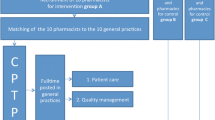Abstract
Purpose
In September 2012 an interactive course on the “Interface Management of Pharmacotherapy” was organized by the Stockholm Drug and Therapeutics Committee in cooperation with Department of Clinical Pharmacology at Karolinska Institutet and at Karolinska University Hospital in Stockholm, Sweden, in collaboration with the WHO. The basis for the course was the “Stockholm model” for the rational use of medicines but also contained presentations about successful models in interface management of pharmacotherapy in other European countries.
Methods
The “Stockholm model” consists of 8 components: 1) Independent Drug and Therapeutics Committee with key role for respected drug experts with policy for “interest of conflicts”, 2) The “Wise List”, recommendations of medicines jointly for primary and hospital care, 3) Communication strategy with continuous medical education, 4) Systematic introduction of new expensive medicines, 5) E-pharmacological support at “point of care”, 6) Methods and tools for follow-up of medicines use, 7) Medicines policy strategy and 8) Operative resources.
Results
The course highlighted the importance of efficient and targeted communication of drug recommendations building on trust among prescribers and patients for the guidelines to achieve high adherence. Trust is achieved by independent Drug and Therapeutics Committees with a key role for respected experts and a strict policy for “conflicts of interest”. Representations of GPs are also crucial for successful implementation, being the link between evidence based medicine and practice.
Conclusion
The successful models in Scotland and in Stockholm as well as the ongoing work in Catalonia were considered as examples of multifaceted approaches to improve the quality of medicine use across primary and hospital care.

Similar content being viewed by others

References
Diogene E, Figueras A (2011) What public policies have been more effective in promoting rational prescription of drugs? J Epidemiol Community Health 65(5):387–388
Laing R, Waning B, Gray A, Ford N (2003) E. t Hoen, 25 years of the WHO essential medicines lists: progress and challenges. Lancet 361(9370):1723–1729
Gustafsson LL, Wettermark B, Godman B, Andersen-Karlsson E, Bergman U, Hasselstrom J et al (2011) The ‘wise list’- a comprehensive concept to select, communicate and achieve adherence to recommendations of essential drugs in ambulatory care in Stockholm. Basic Clin Pharmacol Toxicol 108(4):224–233
Midlov P, Bergkvist A, Bondesson A, Eriksson T, Hoglund P (2005) Medication errors when transferring elderly patients between primary health care and hospital care. Pharm World Sci 27(2):116–120
Coma A, Zara C, Godman B, Agusti A, Diogene E, Wettermark B et al (2009) Policies to enhance the efficiency of prescribing in the Spanish Catalan region: impact and future direction. Expert Rev Pharmacoecon Outcomes Res 9(6):569–581
Dear J, O’Dowd C, Timoney A, Paterson KR, Walker A, Webb DJ (2007) Scottish Medicines Consortium: an overview of rapid new drug assessment in Scotland. Scott Med J 52(3):20–26
Laing R, Ruredzo R (1989) The essential drugs programme in Zimbabwe: new approaches to training. Health Policy Plan 4(3):229–234
Laing R (1991) Essential drugs programmes in Africa. Afr Health 14(1):32–33
Forløpsgruppe “Riktig legemiddelbruk” (2009) Oslo, Norway. http://www.regjeringen.no/upload/HOD/Dokumenter%20SAM/Forl%C3%B8psrapporter/Forl%C3%B8psgruppe%206%20-%20Riktig%20legemiddelbruk.pdf Date of access: Feb 12th 2013
En helhetlig integreringspolitikk. Mangfold og fellesskap (2012–2013) Melding til Stortinget: Oslo, Norway. http://www.regjeringen.no/nb/dep/hod/dok/regpubl/stmeld/2010-2011/meld-st-16-20102011/8/6.html?id=639843. Date of acess: Feb 12th 2013
Spinewine A, Foulon V, Claeys C, Lepeleire JD, Chevalier P, Desplenter F (2010) Seamless care focusing on medication between hospital and home. Belgian Health Care Knowledge Centre (KCE), Brussels
Vogler S, Habl C, Leopold C, Mazag J, Morak S, Zimmermann N (2010) PHIS hospital pharma report. Pharmaceutical Health Information System (PHIS), Vienna
Grol R, Grimshaw J (2003) From best evidence to best practice: effective implementation of change in patients’ care. Lancet 362(9391):1225–1230
Sjöqvist F, Bergman U, Dahl ML, Gustafsson LL, Hensjö LO (2002) Drug and therapeutics committees: a Swedish experience. Drug Inf 12:207–213, WHO
Godman B,Gustafsson LL (2013) A new reimbursement system for innovative pharmaceuticals combining value-based and free market pricing. Correspondence. Appl Health Econ Health Policy 11:79–82
Persson U, Svensson J, Pettersson B (2012) A new reimbursement system for innovative pharmaceuticals combining value-based and free market pricing. Appl Health Econ Health Policy 10(4):217–225
Abernethy D, Birkett D, Brosen DK, Cascorbi I, Gustafsson LL, Hoppu K et al (2012) Clinical pharmacology in health care, teaching and research. Joint publication by WHO, CIOMS and IUPHAR (International Union of Pharmacology and Clinical Pharmacology). WHO, Geneva. Available at: http://www.cioms.ch/index.php/component/booklibrary/?task=view&Itemid=&id=46&catid=58
Godman B, Paterson K, Malmstrom RE, Selke G, Fagot JP, Mrak J (2012) Improving the managed entry of new medicines: sharing experiences across Europe. Expert Rev Pharmacoecon Outcomes Res 12(4):439–441
Holmstrom M, Johnsson H, Larfars G, Malmstrom R, Hjemdahl P (2009) New drug in atrial fibrillation—how does it function in regular health care? Lakartidningen 106(45):3019–3020
Covvey JR, McTaggart S, Bishop I (2010) Management of medication use in Scotland. Am J Health Syst Pharm 67(16):1378–1382
Bottiger Y, Laine K, Andersson ML, Korhonen T, Molin B, Ovesjo ML et al (2009) SFINX-a drug-drug interaction database designed for clinical decision support systems. Eur J Clin Pharmacol 65(6):627–633
Sjoborg B, Backstrom T, Arvidsson LB, Andersen-Karlsson E, Blomberg LB, Eiermann B et al (2007) Design and implementation of a point-of-care computerized system for drug therapy in Stockholm metropolitan health region–Bridging the gap between knowledge and practice. Int J Med Inform 76(7):497–506
Kotler P (2000) Marketing management, 10th edn. ed. New Jersey: Upper Saddle River
Acknowledgments
This work was in part supported by grants from the Karolinska Institutet, Sweden. No writing assistance was provided for this paper.
Financial disclosure
There are no conflicts of interest reported by any of the authors. However, Eva Andersén-Karlsson is chairman of the DTC in Stockholm County Council.
Author information
Authors and Affiliations
Corresponding author
Rights and permissions
About this article
Cite this article
Björkhem-Bergman, L., Andersén-Karlsson, E., Laing, R. et al. Interface management of pharmacotherapy. Joint hospital and primary care drug recommendations. Eur J Clin Pharmacol 69 (Suppl 1), 73–78 (2013). https://doi.org/10.1007/s00228-013-1497-5
Received:
Accepted:
Published:
Issue Date:
DOI: https://doi.org/10.1007/s00228-013-1497-5


